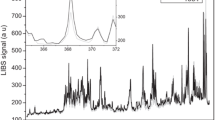Abstract
Femtosecond laser-induced breakdown spectroscopy (fs-LIBS) is employed to analyze the element content in poplar tree leaves from four representative locations in Changchun City (Jingyue National Forest Park, JYP), Changchun University of Science and Technology (CUST), Casting Factory (CF) and Forging Factory (FF) of First Automobile Works (FAW) under identical experimental conditions. Those elements of N, P, K, Ca, Fe, Ti, Mn and Na are identified in the poplar tree leaves from the recorded spectrogram and the elemental content in the leaves is further obtained by applying free calibration method to the spectrogram. Our results show that the elements Ca and Fe in the poplar tree leaves from the CF area have the highest concentration in the four locations, which is a factor of 2.05 and 1.66 respectively to those of JYP. This experiment demonstrates that fs-LIBS can be utilized to analyze element content in a sample and find new applications in the environmental detection.
Similar content being viewed by others
References
Myriam B, Hao Z Q, Matthieu B, et al. Femtosecond laser-induced breakdown spectroscopy for detection of trace elements in sophora leaves. Chin Phys Lett, 2007, 24(12): 3466–3468
Vincent P, Jhanis G, Mao X L, et al. Micro-crater laser induced breakdown spectroscopy—an analytical approach in metals samples. AIP Conf Prec, 2008, 992(1): 1166–1171
Cui Z F, Zhang X Y, Yao G X, et al. Quantitative analysis of the trace element in Cu-Pb alloy by LIBS (in Chinese). Acta Phys Sin, 2006, 55(9): 4506–4513
Koch S, Garen W, Muller M, et al. Detection of chromium in liquids by laser induced breakdown spectroscopy (LIBS). Appl phys A: Mater Sci Process, 2004, 79(4-6): 1071–1073
Colao F, Fantoni R, Lazic V, et al. LIBS application for analyses of martian crust analogues: Search for the optimal experimental parameters in air and CO2 atmosphere. Appl phys A: Mater Sci Process, 2004, 79(1): 143–152
Klein S, Stratoudaki T, Zafiropulos V, et al. Laser-induced breakdown spectroscopy for on-line control of laser cleaning of sandstone and stained glass. Appl phys A: Mater Sci Process, 1999, 69(4): 441–444
Rodriguez-Celis M, Gornushkin B, Heitmann M, et al. Laser induced breakdown spectroscopy as a tool for discrimination of glass for forensic applications. Anal Bioanal Chem, 2008, 391(5): 1618–2642
De Lucia F C, Gottfried J L, Munson C A, et al. Current status of standoff LIBS security applications at the United States Army Research Laboratory. Spectroscopy, 2009, 24(6): 32–38
Sun L X, Yu H B. Simultaneous quantitative analysis of multielements in Al alloy samples by laser-induced breakdown spectroscopy. Spectrosc Spectral Anal, 2009, 29(12): 3375–3378
Pershin S M, Colao F, Spizzichino V. Quantitative analysis of bronze samples by laser-induced breakdown spectroscopy (LIBS): A new approach, model, and experiment. Laser Phys, 2006, 16(3): 455–467
Xie C, Lu J D, Yao S C, et al. Quantitative analysis and material identification by laser induced breakdown spectroscopy. Laser Optoelectron Progress, 2009, 46(11): 65–72
Sun D X, Su M G, Dong C Z, et al. Quantitative analysis of element concentration in Al alloy by using laser-induced breakdown spectroscopy (in Chinese). Acta Phy Sin, 2010, 59(7): 4571–4576
Lau O W, Luk S F. Leaves of Bauhinia blakeana as indicators of atmospheric pollution in Hong Kong. Atmos Environ, 2001, 35(18): 3113–3120
Myriam B, Hao Z Q, Matthieu B, et al. Femtosecond laser-induced breakdown spectroscopy for detection of trace elements in sophora leaves. Chin Phys Lett, 2007, 24(12): 3466–3468
Samek O, Lambert J, Hergenröder R, et al. Femtosecond laser spectrochemical analysis of plant samples. Laser Phys Lett, 2006, 3(1): 21–25.
Ciucci A, Corsi M, Palleschi V, et al. New procedure for quantitative elemental analysis by laser-induced plasma spectroscopy. Appl Spectrosc, 1999, 53(8): 960–964
Meng J P, Yang J G, Jin L H. Measurement of temperature space distribution of the Cu laser plasma. Laser J, 2001, 22(4): 22–24
Su M G, Chen G Y, Zhang S D, et al. The soace characteristic research of laser induced Cu plasma spectra. Appl Laser, 2004, 24(6): 409–412
Liu Q, Zhou X, Li Y C, et al. Temperature detection of plasma by technology of laser induced breakdown spectroscopy. Optics Optoelectron Technol, 2008, 6(5): 12–14
Author information
Authors and Affiliations
Corresponding author
Rights and permissions
About this article
Cite this article
Ma, S., Gao, X., Guo, K. et al. Analysis of the element content in poplar tree leaves by femtosecond laser-induced breakdown spectroscopy. Sci. China Phys. Mech. Astron. 54, 1953 (2011). https://doi.org/10.1007/s11433-011-4493-8
Received:
Accepted:
Published:
DOI: https://doi.org/10.1007/s11433-011-4493-8



